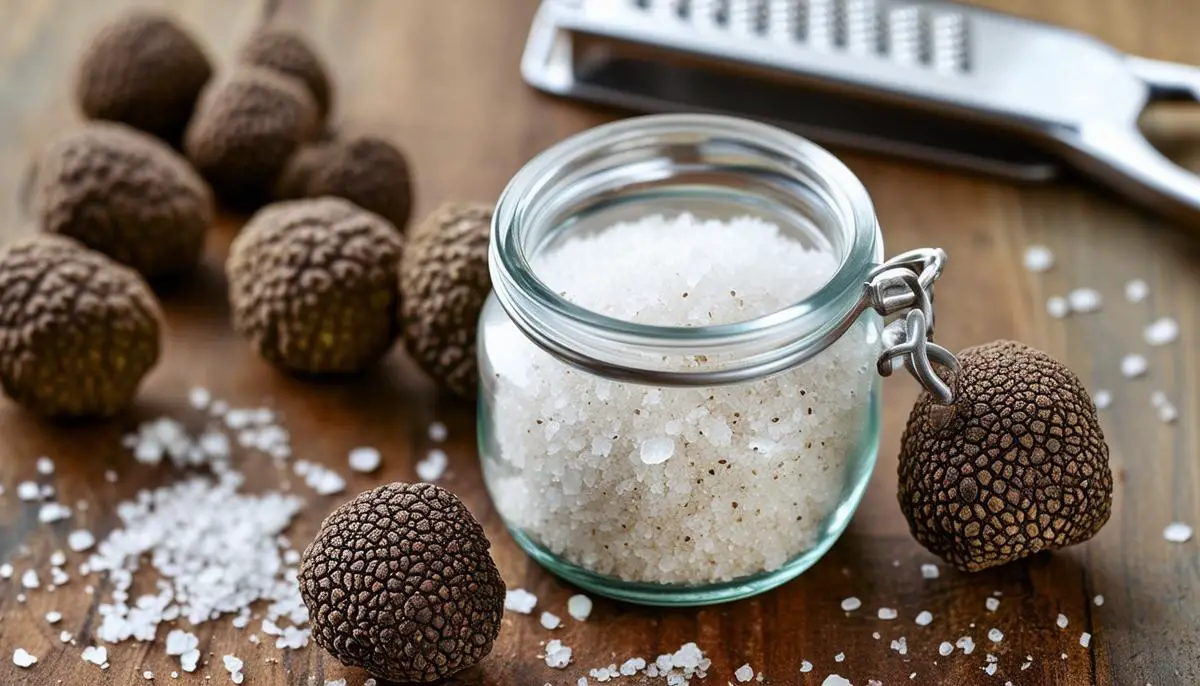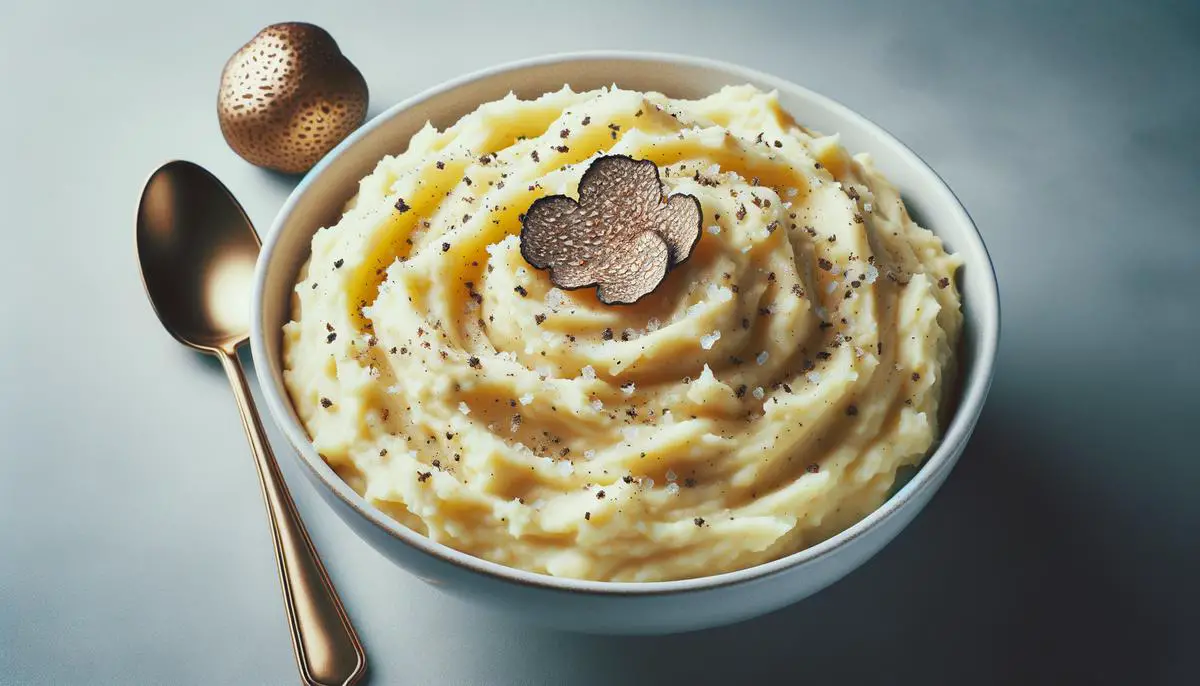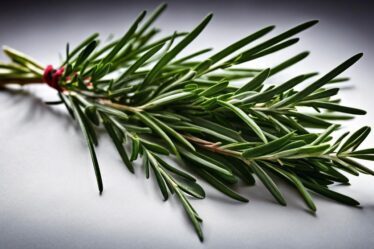
Introduction to Truffle Salt
A sprinkling of truffle salt transforms ordinary dishes into exquisite culinary experiences, distinguished by its delicate fusion of sea salt with fragrant truffle bits. Typically crafted from either revered black or esteemed white truffles, this special ingredient descends from the prized fungi family notable for their rarity and intricate flavor profiles. Black truffles from regions like France's Périgord and white truffles from Italy's Piedmont lend their sensational earthy and musky tastes to the salt, presenting an expression of luxury in every grain.
The potent aroma distinct to truffles marks even the smallest amount of truffle salt as pivotal in transforming dishes, signifying its gourmet attribute; it releases a deep, almost intoxicating scent that penetrates and elevates from simple scrambled eggs to more luxurious risottos.
In the niche of gourmet cooking, truffle salt occupies a special status, not only because of the prestige of its primary ingredient but due to its utility in enhancing the flavors of varied dishes without overtaking them. The subtle merge of truffle essence with the crystalline nature of salt doesn't overpower but enriches—a sprinkle here and there introduces a complex layer of flavor dedicated gourmands seek out feverishly.
As culinarians drift toward testing the boundaries of traditional flavors, the integration of truffle salt serves as testament to centuries-old gastronomic luxuries preserved in the modern palate. It's an experience—every teaspoon a historical journey, every dish a bridge from the rustic roots of Old World truffle foraging to contemporary fine dining plates. Each morsel seasoned whispers tales of clandestine harvests, elusive woodland treasures, and the continuum of human ingenuity in celebrating nature's riches. Thus, truffle salt rests not merely on the tongues of the epicurean enthusiasts but resides deeply within their culinary souls.
Culinary Applications of Truffle Salt
Truffle salt elevates even the most basic recipes into realms of elegant dining merely with a subtle sprinkle. Its importance in both transformation and enhancement of everyday foods cannot be overstressed; it enriches flavors without masking them, striking an impeccable balance that sophisticated palates appreciate.
One might start the day on a luxurious note by adding truffle salt to breakfast dishes. Simple scrambled eggs, when seasoned with a pinch of truffle salt immediately before serving, offer an elevated experience with a burst of earthy profundity.
In main courses, the versatility of truffle salt shines brightly through its application in risottos and pastas. A risotto, inherently creamy and rich, can be lifted tremendously by incorporating truffle salt either during the whipping process or as a finishing touch just before serving. This enhancement gives it a woody depth that complements the dish's creaminess, perfect for sophisticated dinners. Pasta dishes also greatly benefit from the addition of truffle salt. Lightly salting a simple aglio e olio—garlic and oil pasta—emboldens the garlic while pairing unexpectedly well with the olive oil.
For bakers and those inclined toward artisanal breads, blending a small quantity of truffle salt with softened butter creates an addictive compound butter perfect for spreading on warm slices. This butter also performs exceptionally well as a steak finisher, adding a captivating layer of flavor as it melts seductively over the hot surface of a cooked cut.
Truffle salt impeccably modernizes everyday popcorn. Tossed with a light drizzle of olive oil and a conservative sprinkle of truffle salt, popcorn settles into a categorically regal snack fit for entertaining guests or indulging on movie nights.
Through these implementations—ranging from breakfast to snacks—truffle salt fosters sophisticated flavor profiles in otherwise straightforward dishes. Its capacity to enhance and transform fare is a culinary asset for any modern kitchen, aligning old-world luxury with contemporary eating habits effortlessly.

Making Your Own Truffle Salt
To make your own truffle salt at home, you only need two basic ingredients and a straightforward method. Here's how you can prepare and preserve this luxurious seasoning using high-quality sea salt flakes and fresh truffles:
Ingredients:
- 100 grams of high-quality sea salt flakes
- 10 grams of fresh black truffles
Instructions:
- Begin by cleaning the fresh truffles gently with a brush to remove any soil, ensuring not to wash with water as this could introduce moisture that impacts the dryness of your final product.
- Using a fine grater or microplane, carefully grate the fresh truffles over a clean bowl.
- Combine the grated truffles with the sea salt flakes in the bowl. Use a spoon or your fingers to mix, ensuring the truffle is evenly distributed throughout the salt.
- Spread the mixture in a thin, even layer on a baking sheet lined with parchment paper.
- Set your oven to the lowest possible temperature, or use a dehydrator if available, to dry the truffle and salt mixture. The goal is to dehydrate it without cooking it, which typically means setting the oven at about 95°F (35°C). Leave the mixture in the oven or dehydrator for about 12 hours or until completely dry.
- Once dry, transfer the truffle salt to an airtight container and store it in a cool, dark place to help maintain its aromatic quality. Avoid exposure to direct sunlight or moisture.
Storage:
Proper storage is key to preserving the freshness and flavor of your homemade truffle salt. Keep it in an airtight glass jar away from heat and light. When stored correctly, homemade truffle salt can maintain its peak flavor for up to three months. After this period, it can still be used, but its iconic truffle aroma might have diminished somewhat.
Following these steps will help you create a truly special seasoning that can add a touch of gourmet to many dishes in your culinary repertoire.

Truffle Salt Recipe: Elevated Mashed Potatoes
Ingredients:
- 2 pounds of Yukon Gold potatoes, peeled and cubed
- 4 tablespoons of unsalted butter
- 1 cup of whole milk
- 1 to 1.5 teaspoons of truffle salt, adjusted according to taste
- Freshly ground black pepper, to taste
Steps:
- Start by placing the cubed Yukon Gold potatoes in a large pot and cover them with cold water to about an inch above the potatoes.
- Set the pot over high heat and bring the water to a boil. Once boiling, reduce the heat to a simmer and cook the potatoes until they are fork-tender, about 15-20 minutes.
- While the potatoes are cooking, heat the milk and butter in a small saucepan over low heat until the butter is melted and the milk is warm. Do not let it boil.
- Once the potatoes are tender, drain the water and return the potatoes to the same pot. Using a potato masher, begin to mash the potatoes until most of the lumps are gone.
- Gradually add the warm milk and butter mixture to the mashed potatoes, continuing to mash until they are smooth and creamy. Avoid overworking the potatoes to keep the texture light and fluffy.
- Stir in the truffle salt, starting with a teaspoon, then tasting and adding more if needed. Grind in some fresh black pepper to taste.
- Serve the mashed potatoes warm, perhaps with an additional sprinkle of truffle salt or a dollop of butter on top for added richness.
Nutritional information per serving (based on 6 servings):
- kcal: 220
- carbohydrates: 32g
- protein: 4g
- fat: 9g
- sodium: 380mg (varies based on amount of truffle salt used)
Choosing Yukon Gold potatoes for this recipe is ideal because they have a naturally buttery flavor and creamy texture that pairs wonderfully with the luxurious hint of truffle salt. The process of mashing should be done gently to ensure the potatoes remain light and absorb the flavors effectively.

- Harrington RJ. The Culinary Uses of the Black Truffle. Journal of Culinary Science & Technology. 2016;14(3):212-226.
- Berrueta LA, Alonso-Salces RM, Héberger K. Supervised pattern recognition in food analysis. Journal of Chromatography A. 2007;1158(1-2):196-214.



